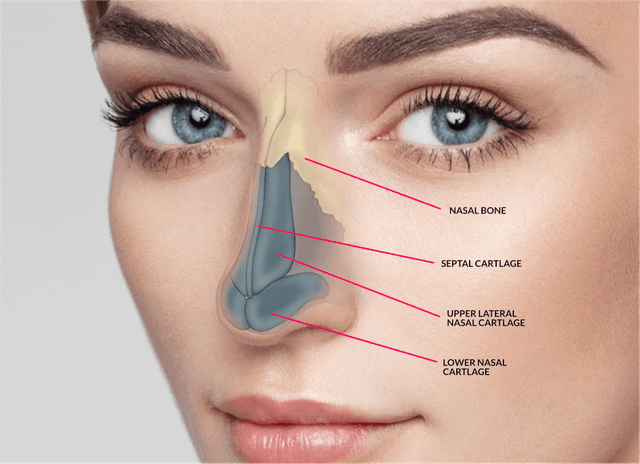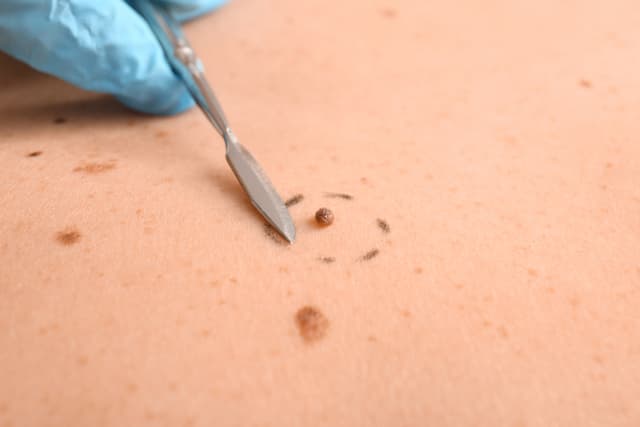If you’re considering flat moles removal, you may be concerned about scarring. The good news is that when you get moles removed, the scar is usually minimal. Whether you have moles removed for cosmetic reasons or because skin cancer is present, it’s an outpatient procedure performed right in your doctor, dermatologist, or plastic surgeon’s office. Let’s discuss the types of mole removal techniques, what you can expect when it comes to scarring, and how to promote healing after your surgery.
Types of Mole Removal Procedures
Mole removal is a straightforward procedure, but there are some immediate changes to the skin. The extent of the changes vary based on the method used. At Ardesh Facial Plastic Surgery, Dr. Ardesh performs shave removal and excision surgery.
Shave Removal
Shave removal, also known as shave excision, is a minimally invasive mole removal procedure. With this method, Dr. Ardesh will administer local anesthesia and carefully shave off the elevated portion of the mole with a scalpel or razor blade.
Shave excision is the preferred removal method for benign moles that protrude above the skin surface. This is a quick, low risk procedure with a brief healing process.
Shave removal leaves a minimal scar that often looks like a smoothed over part of the surrounding skin.
Excision Surgery
Surgical excision is a more invasive approach to mole removal. This method is typically used for removing atypical moles or those that are suspected to be cancerous.
Like with a shave excision, Dr. Ardesh will administer local anesthesia to numb the area. Using a scalpel, he will carefully cut out the entire mole, including a surrounding margin of healthy skin to ensure the entire mole and all cancer cells are removed. The wound is then closed with stitches.
Since excision is more invasive, it often leaves a more noticeable scar than shave excision. The size of the scar depends on the size of the mole that was removed and the number of stitches needed. Dr. Ardesh takes care to remove the mole in a way that reduces scarring. Proper wound care can also help reduce the appearance of scars.
There are other methods—including laser removal with a UV light and freezing with liquid nitrogen—that may be suitable for you. If you have questions about which procedure is best for your situation, contact us. We’re happy to help.
Stages of the Mole Removal Healing Process
The healing timeline for mole removal wounds is divided into three stages:
- Inflammatory Stage – Named so because inflammation is at its peak. This stage begins around 12 hours post-op and lasts approximately 5 days.
- Proliferation Stage – This stage overlaps with the inflammatory phase as it begins within 24 hours of surgery. It lasts for around 7 days.
- Maturation Stage – The final phase of healing, it lasts for up to one year after your mole removal.
Short-Term Mole Removal Aftercare
The immediate healing process varies from person to person and is influenced by your skin type, the removal method used, and how closely you follow aftercare instructions. With that in mind, here’s a general overview of what you can expect in the weeks following mole removal:
- You will have swelling and redness, but this typically subsides within a few days.
- If a scab forms, do not pick at it. Doing so may result in a more noticeable mole removal scar. The scab will fall off on its own as the skin underneath heals.
- You’ll be able to resume normal activities—including exercise—shortly after removing a mole. Strenuous activities or exercise that strains the treated area should be avoided for 2 – 3 weeks after your mole removal.
- Keep the treated area out of the sun, as direct exposure can cause a more noticeable scar. Even after the area fully heals, use sun protection whenever possible.
How to Promote Healing After Having a Mole Removed
The best way to ensure your mole removal wound heals properly? Following the aftercare instructions provided by Dr. Ardesh. Here are a few things you can do during the inflammatory and proliferation stages to help your skin heal and prevent infection:
- Keep the wound area elevated and apply cold compresses to minimize swelling and ease any pain.
- Clean the affected area by rinsing with mild soap and water once or twice per day.
- After cleaning, apply petroleum jelly or over-the-counter ointments to keep the wound moist.
- Apply a clean bandage to the wound once or twice per day.
- Gentle massage to the treated area can increase blood flow and promote tissue healing.
- To keep inflammation at a minimum, avoid smoking and excessive alcohol use after your surgery.
Long-Term Changes and Scarring After Mole Removal
The healing time for a mole removal procedure varies, but most patients are considered healed after 2 – 3 weeks. The scar you have at this point is not how it will look forever, though. Your scar will begin to fade around the three-month mark and should continue to do so for a year. Around one year post-surgery, your scar healing will be complete.
Your mole removal scar may be flat, raised, or indented. Excision surgical mole removal usually results in a raised or indented scar, while patients that have shave excisions typically have a flat scar. As healing tissue begins to form, it is normal for scars to be red, stiff, and raised. As time goes on, their appearance will improve and they will flatten out.
You may see changes in the color of your skin in the treated area, such as the skin darkening or lightening. This is common and not cause for concern. Over the course of the first year, changes in pigmentation will improve.
During the healing process, there are a few things you can do to minimize the look of your mole removal scar:
- Continue to keep the area out of the sun. Exposure can impact scar formation for the first year and beyond.
- Over the counter ointments or sheets can help minimize scarring. Do not apply these until the area has healed and the wound is no longer open.
- Be sure to keep any follow-up appointments with your doctor. These appointments will help monitor healing and allow you to address any concerns with your provider.
Get on the Road to Healing with Dr. Ardesh
While scarring is a natural part of the mole removal process, being persistent with post-procedure care can make a big difference in the final appearance of your scar. At The Mole Doctor TM and The Beauty Mark Doctor TM, we emphasize patience, proper care, and open communication with your healthcare provider to ensure a smoother post-procedure experience. To start your mole removal journey, contact Dr. Ardesh’s team by calling (424) 242-8608 or requesting your appointment online.



